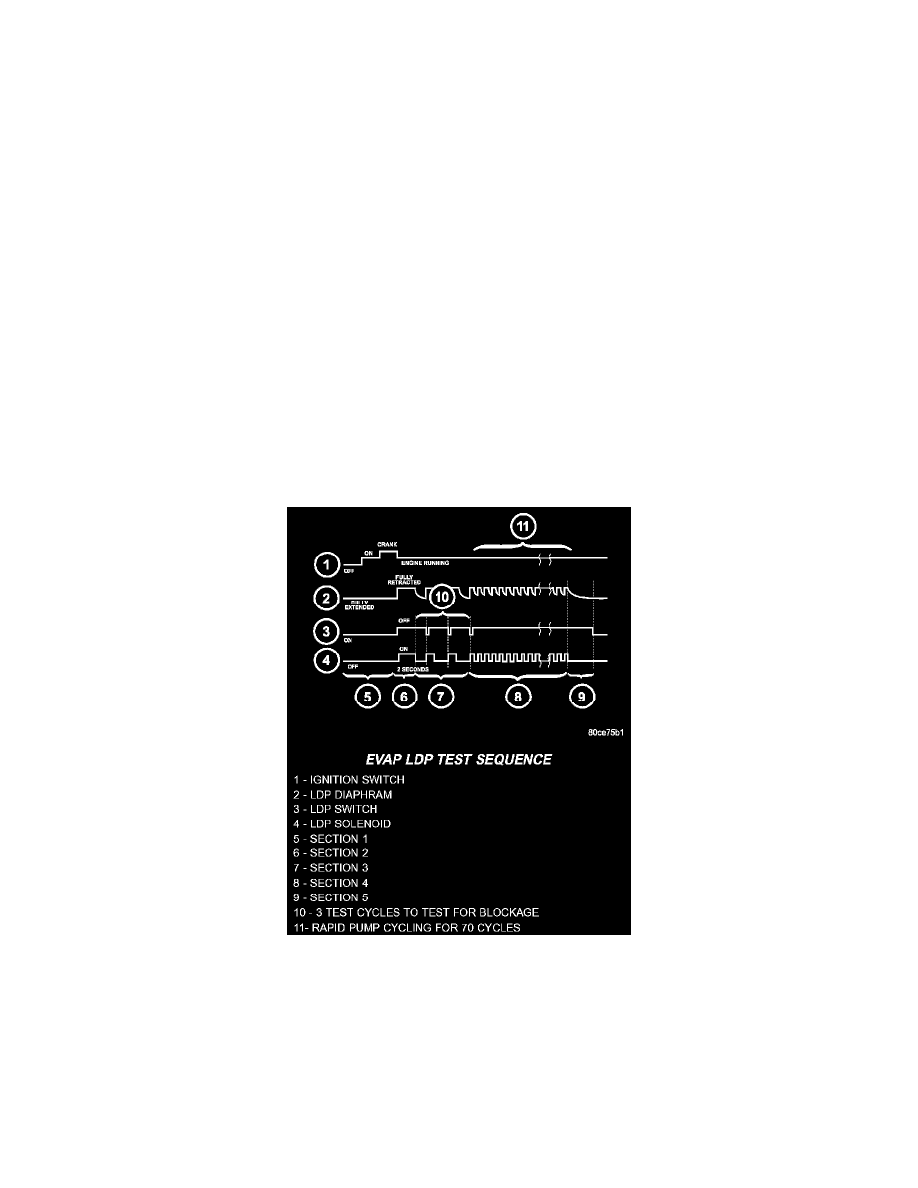RAM 1500 Truck 4WD V8-5.9L VIN Z (2002)

than expected (approximately 6 to 10 seconds) the PCM will suspect a blockage. On the next drive when Enabling Conditions are met, the test will
run again. If blockage is again detected, P1486 is stored, and the MIL is illuminated.
SECTION 4 - No DTC Can Be Set During This Time- After the LDP blockage tests are completed, the PCM then tests for EVAP system leakage.
First, the PCM commands the LDP to rapidly pump for 20 to 50 seconds (depending on fuel level) to build pressure in the EVAP system. This
evaluates the system J18-24-0 to see if it can be sufficiently pressurized. This evaluation (rapid pump cycling) may occur several times prior to leak
checking. The LDP reed switch does not close and open during rapid pumping because the diaphragm does not travel through its full range during this
part of the test.
SECTION 5 - P0456, P0442, P0455 EVAP Leak Monitor and Leak Detected- Next, the PCM performs one or more test cycles by monitoring the
time required for the LDP reed switch to close (diaphragm to drop) after the LDP solenoid is turned OFF.
If the switch does not close, or closes after a long delay, it means that the system does not have any significant leakage and the EVAP Leak Detection
Test is complete.
However, if the LDP reed switch closes quickly, there may be a leak or the fuel level may be low enough that the LDP must pump more to finish
pressurizing the EVAP system. In this case, the PCM will rapidly pump the LDP again to build pressure in the EVAP system, and follow that by
monitoring the time needed for several LDP test cycles. This process of rapid pumping followed by several LDP test cycles may repeat several times
before the PCM judges that a leak is present.
When leaks are present, the LDP test cycle time will be inversely proportional to the size of the leak. The larger the leak, the shorter the test cycle
time. The smaller the leak, the longer the test cycle time. DTC's may be set when a leak as small as 0.5 mm (0.020") diameter is present.
If the system detects a leak, a temporary fault will be stored in PCM memory The time it takes to detect a 0.020, 0.040, or Large leak is based on
calibrations that vary from model to model. The important point to remember is if a leak is again detected on the next EVAP Leak Detection Test, the
MIL will illuminate and a DTC will be stored based on the size of leak detected. If no leak is detected during the next test, the temporary fault will be
cleared.
EVAP LDP Test Sequence
DIAGNOSTIC TIPS During diagnosis, you can compare the LDP solenoid activity with the monitor sequence in Figure 6. If the PCM detects a
problem that could set a DTC, the testing is halted and LDP solenoid activity will stop. As each section of the test begins, it indicates that the previous
section passed successfully. By watching to see which tests complete, you can see if any conditions are present that the PCM considers abnormal.
For example, if the LDP solenoid is energized for the test cycles to test for blockage (P1486), it means that the LDP has already passed its test for
P1494. Then, if the PCM detects a possible blockage, it will set a temporary fault without turning ON the MIL and continue the leak portion of the
test. However, the PCM will assume that the system is already pressurized and skip the rapid pump cycles.
Always diagnose leaks, if possible, before disconnecting connections. Disconnecting connections may mask a leak condition.
